Microlife BP3GU1-7B Digital Blood Pressure Monitor User Manual IB BP A6 BT EN 3215
Microlife Corporation Digital Blood Pressure Monitor IB BP A6 BT EN 3215
User Manual

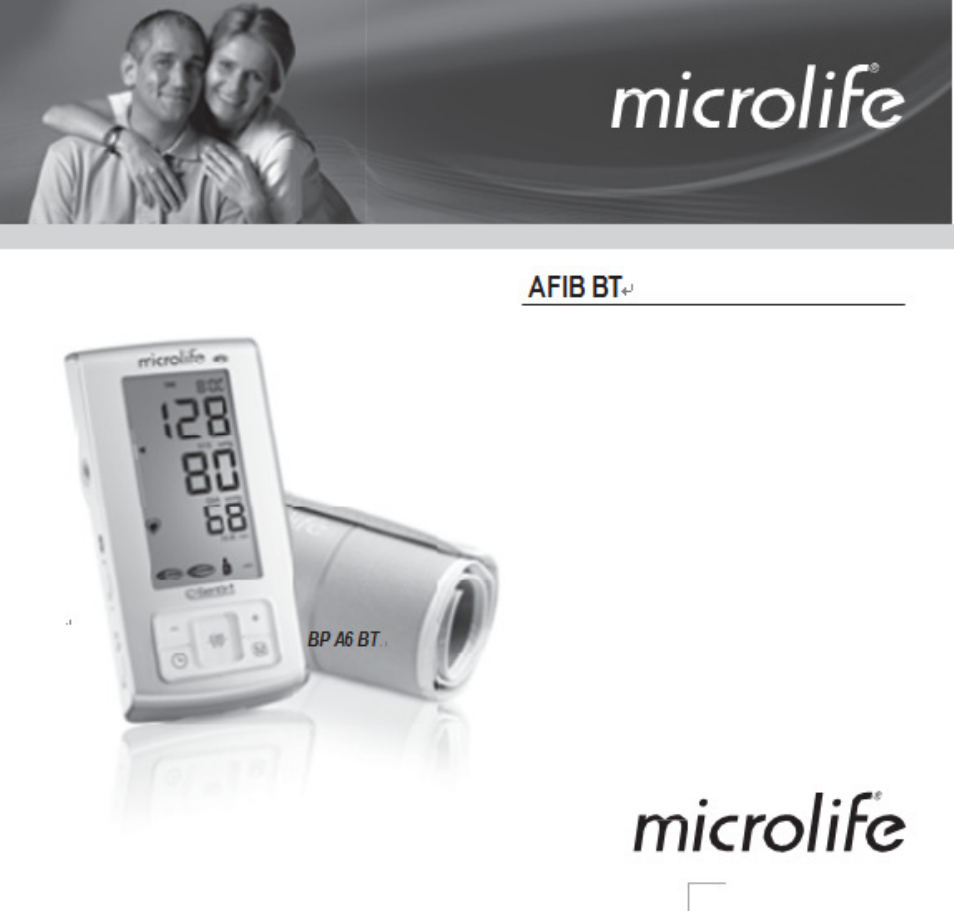
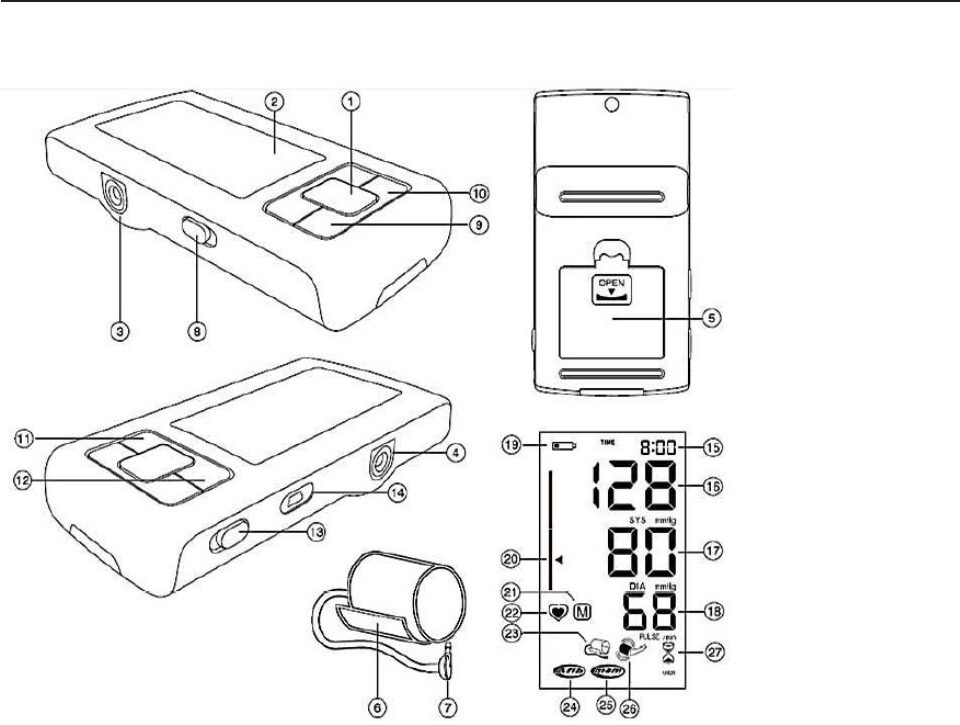
Microlife AFIB BT – BP A6 BT
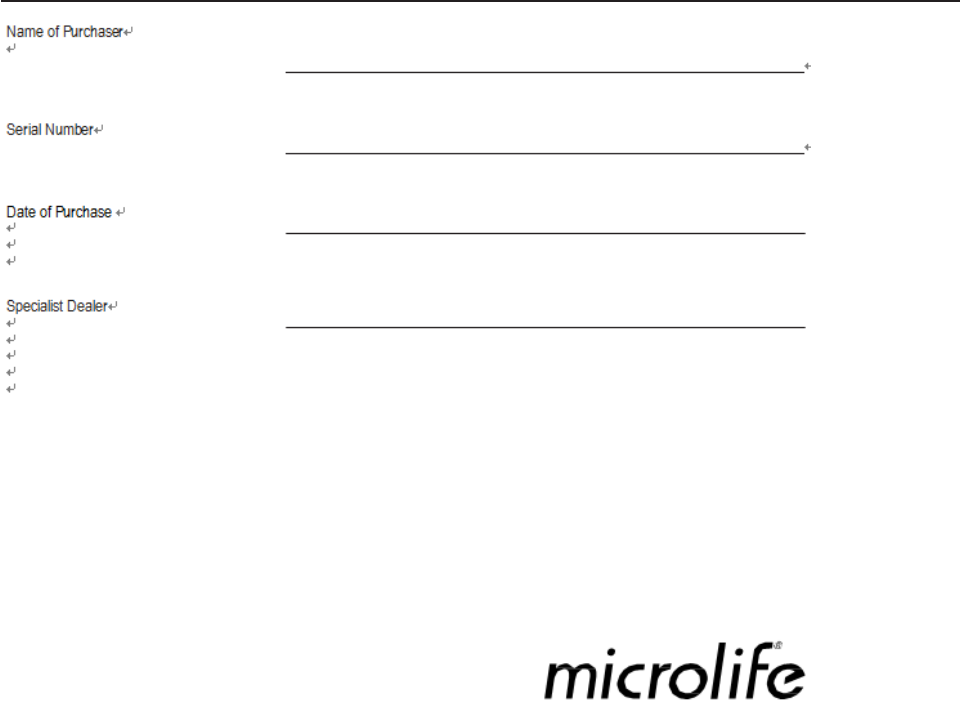
Microlife AFIB BT – BP A6 BT

Microlife AFIB BT – BP A6 BT
(1) START/STOP Button
(2) Display
(3) Cuff Socket
(4) Mains Adapter Socket
(5) Battery Compartment
(6) Cuff
(7) Cuff Connector
(8) AFIB/MAM Switch
(9)
Time Button
(10) M-button (memory)
(11)
- «Backward» Button
(12)
+ «Forward» Button
(13)
Lock Switch
(14) USB Port
Display
(15) Date/Time
(16) Systolic Value
(17)
Diastolic Value
(18)
Pulse Rate
(19) Battery Display
(20) Traffic Light Display
(21) Stored Value
(22) Pulse Indicator
(23) Cuff Check Indicator
(24) Atrial Fibrillation Indicator (AFIB)
(25) AFIB/MAM Mode
(26) Arm Movement Indicator
(27) MAM Interval Time
Read the instructions carefully before using this device
Type BF applied part

Microlife AFIB BT – BP A6 BT
Dear Customer,
Your new Microlife blood pressure monitor is a reliable medical
device for taking measurements on
the upper arm. It is simple to
use, accurate and comes highly recommended for blood pressure
monitoring in your home. This device was developed in collaboration with physicians and clinical
tests carried out prove its
measurement accuracy to be of a very high standard.*
Microlife AFIB detection is the world’s leading digital blood pres-
sure measurement technology for
the detection of atrial fibrillation
(AFIB) and hypertension. These are the two top risk factors of
getting a stroke or heart disease in the future. It is important to
detect AFIB and hypertension at an
early stage, even though you
may not experience any symptoms. Appropriate treatment will
reduce
your risk of suffering a stroke. For this reason, it is recommended that you visit your doctor when
the device gives an AFIB
signal during your blood pressure measurement. The AFIB algorithm of
Microlife has been clinically investigated by several prominent clinical investigators and showed
that the device detects patients with AFIB at a certainty of 97-100%. 1,2
Please read through these instructions carefully so that you under-
stand all functions and safety
information. We want you to be
happy with your Microlife product. If you have any questions, prob
-
lems or want to order spare parts please contact Microlife-
Customer Service. Your dealer or
pharmacy will be able to give
you the address of the Microlife dealer in your country. Alternatively,
visit the internet at www.microlife.com where you will find a
wealth of invaluable information on our
products.
Stay healthy – Microlife AG
*This device uses the same measuring technology as the award
winning «BP 3BTO-A» model
tested according to the British
Hypertension Society (BHS) protocol.
1. Stergiou GS, Karpettas N, Protogerou A, Nasothimiou EG, &
Kyriakidis M. Diagnostic
accuracy of a home blood pressure
monitor to detect atrial fibrillation. J Hum Hyperten 2009;
1-5.
2. Wiesel J, Fitzig L, Herschman Y, & Messineo FC Detection of
Atrial Fibrillation Using a Modified
Microlife Blood Pressure
Monitor.
Am J Hypertens 2009; 848-852.

Microlife AFIB BT – BP A6 BT
Table of Contents
1.
Important Facts about Blood Pressure and Self-Measurement
•
How do I evaluate my blood pressure?
2.
Important Facts about Atrial Fibrillation (AFIB)
•
What is Atrial Fibrillation (AFIB)?
•
How does AFIB impact my family or me?
•
Microlife AFIB detection provides a convenient way to
screen for AFIB (only in AFIB/MAM
mode)
•
Risk factors you can control
3.
Using the Device for the First Time
•
Inserting the batteries
•
Setting the date and time
•
Selecting the correct cuff
•
Select the measuring mode: standard or AFIB/MAM mode
•
AFIB/MAM mode (highly recommended)
4.
Taking a Blood Pressure Measurement using this Device
•
How not to store a reading
5.
Appearance of the Atrial Fibrillation Indicator for early
Detection (only in AFIB/MAM
mode)
6.
Traffic Light Indicator in the Display
7.
PC-Link Functions
•
Installation and data transmission
8.
BT-Link Function
•
Installation and data transmission
9.
Data Memory
•
Viewing the stored values
•
Memory full
•
Clearing all values
10.
Battery Indicator and Battery change
•
Low battery
•
Flat battery – replacement
•
Which batteries and which procedure?
•
Using rechargeable batteries
11.
Using a Mains Adapter
12.
Error Messages
13.
Safety, Care, Accuracy Test and Disposal
•
Safety and protection
•
Device care

•
Cleaning the cuff
•
Accuracy test
•
Disposal
14.
Guarantee
15.
Technical Specifications Guarantee Card (see Back Cover)
1. Important Facts about Blood Pressure and Self-
Measurement
•
Blood pressure is the pressure of the blood flowing in the arteries generated by the pumping
of the heart. Two values, the
systolic (upper) value and the diastolic (lower) value, are
always measured.
•
The device indicates the pulse rate (the number of times the
heart beats in a minute).
•
Permanently high blood pressure values can damage your health and must be treated by
your doctor!
•
Always discuss your values with your doctor and tell him/her if
you have noticed anything
unusual or feel unsure. Never rely on single blood pressure readings.
•
There are several causes of excessively high blood pressure
values. Your doctor will
explain them in more detail and offer treatment where appropriate. Besides medication,
weight loss
and exercise can also lower your blood pressure.
•
Under no circumstances should you alter the dosages of any drugs prescribed by your
doctor!
•
Depending on physical exertion and condition, blood pressure
is subject to wide fluctuations
as the day progresses. You should therefore take your measurements in the same
quiet
conditions and when you feel relaxed! Take at least
two readings every time (in the
morning and in the evening) and average the measurements.
•
It is quite normal for two measurements taken in quick succession to produce significantly
different results. Therefore we
recommend to use the MAM technology.
•
Deviations between measurements taken by your doctor or in
the pharmacy and those taken
at home are quite normal, as these situations are completely different.
•
Several measurements provide much more reliable information about your blood pressure than
just one single measurement.
Therefore we recommend to use the MAM technology.
•
Leave a small break of at least 15 seconds between two
measurements.
•
If you suffer from an irregular heartbeat, measurements taken
with this device should be
evaluated with your doctor.
•
The pulse display is not suitable for checking the
frequency of heart pacemakers!
•
If you are pregnant, you should monitor your blood pressure
very closely as it can change
drastically during this time!
This monitor is specially tested for use in pregnancy and preeclampsia. When you detect
unusual high readings in pregnancy, you should measure again after 4 hours. If the
reading is still too high, consult your doctor or gynaecologist.
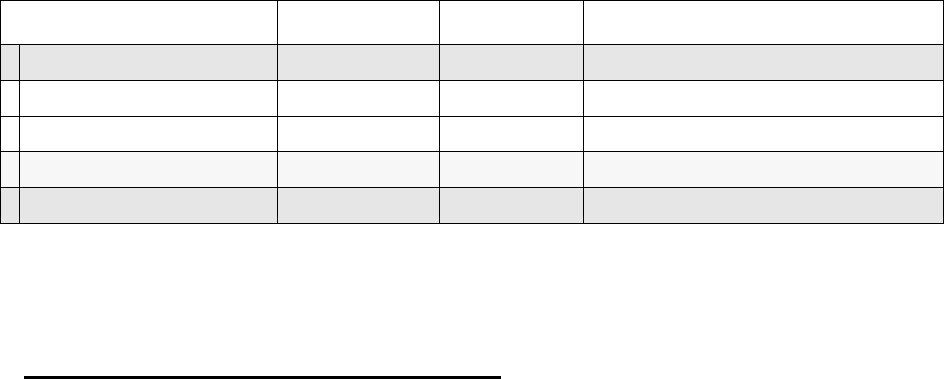
How do I evaluate my blood pressure?
Table for classifying home blood pressure values in adults in
accordance with the international
Guidelines (ESH, AHA, JSH).
Data in mmHg.
Range Systolic Diastolic Recommendation
blood pressure too
low 100 60 Consult your
doctor
1blood pressure
optimum
100 - 130 60 - 80 Self-check
2blood pressure
elevated 130 - 135 80 - 85 Self-check
3blood pressure too
high 135 - 160 85 - 100 Seek medical
advice
4blood pressure
160 100 Urgently seek
medical advice!
The higher value is the one that determines the evaluation.
Example: a blood pressure value of
140/80 mmHg or a value of
130/90 mmHg indicates «blood pressure too high»
2. Important Facts about Atrial Fibrillation (AFIB)
What is Atrial Fibrillation (AFIB)?
Normally, your heart contracts and relaxes to a regular beat.
Certain cells in your heart produce
electrical signals that cause the
heart to contract and pump blood. Atrial fibrillation occurs when
rapid, disorganized electrical signals are present in the heart’s two
upper chambers, called the atria;
causing them to contract irregularly (this is called fibrillation). Atrial fibrillation is the most common
form of heart arrhythmia or irregular heart beat. It often causes no
symptoms, yet it significantly
increases your risk of stroke. You’ll
need a doctor to help you control the problem.
How does AFIB impact my family or me?
People with AFIB have a five-fold higher risk of getting stroke.
Since the chance of having a stroke
increases with age, individuals
above the age of 55 years benefit most from screening for AFIB.
However, for younger individuals with risk factors such as diabetes
or hypertension screening for
AFIB is also recommended. Early
diagnosis of AFIB followed by adequate treatment can
significantly
reduce the risk of getting stroke.
Younger individuals with AFIB have a relatively low risk of getting
stroke as compared to elder
people.
For more information please visit our website: www.microlife.com.
Microlife AFIB detection provides a convenient way to screen
for AFIB (only in AFIB/MAM
mode)
Knowing your blood pressure and knowing whether you or your
family members have AFIB can
help reduce the risk of stroke.
Microlife AFIB detection provides a convenient way to screen for
AFIB whilst taking your blood pressure.
Risk factors you can control
High blood pressure and AFIB are both considered «controllable»
risk factors for strokes. Knowing your
blood pressure and knowing
whether you have AFIB is the first step in proactive stroke prevention.

3. Using the Device for the First Time
Inserting the batteries
After you have unpacked your device, first insert the batteries. The
battery compartment (5) is on the
bottom of the device. Insert the
batteries (4 x size AAA 1.5 V), thereby observing the indicated
polarity. Switch the Lock Switch (13) to «unlock» position.
Setting the date and time
1. After the new batteries are fitted, the year number flashes in the
display. You can set the year by
pressing either the «+» (12) or
the «-» (11) button. To confirm and then set the month, press the
time button (9).
2. Press the «+» (12) or the «-» (11) button to set the month. Press
the time button (9) to confirm and
then set the day.
3. Follow the instructions above to set the day, hour and minutes.
4. Once you have set the minutes and pressed the time button, the
date and time are set and the
time is displayed.
5. If you want to change the date and time, press and hold the time
button down for approx. 3
seconds until the year number starts to flash. Now you can enter the new values as described
above
Selecting the correct cuff
Microlife offers different cuff sizes. Select the cuff size to match the
circumference of your upper
arms (measured by close fitting in the
centre of the upper arm).
Cuff for circumference of upper
S 17 - 22 cm
M 22 - 32 cm
M - L 22 - 42 cm
L - XL 32 - 52 cm
Optional preformed cuffs «Easy» are available for better
fitting and comfort.
Only use Microlife cuffs.
Contact Microlife Service if the enclosed cuff (6) does not fit.
Connect the cuff to the device by inserting the cuff connector (7) into the cuff socket (3) as far as
it will go.
Select the measuring mode: standard or AFIB/MAM mode
This device enables you to select either standard (standard single
measurement) or AFIB/MAM
mode (automatic triple measurement). To select standard mode, slide the AFIB/MAM switch (8) on
the side of the device downwards to position «1» and to select
AFIB/MAM mode, slide this switch
upwards to position «3».
AFIB/MAM mode (highly recommended)
In AFIB/MAM mode, 3 measurements are automatically taken in
succession and the result is then
automatically analysed and
displayed. Because blood pressure constantly fluctuates, a result

determined in this way is more reliable than one produced by a
single measurement. AFIB
detection is only activated in AFIB/
MAM mode.
•
After pressing the START/STOP button (1)
,
the selected AFIB/
MAM mode appears in the
display as the MAM-symbol (25).
•
The bottom, right hand section of the display shows a 1, 2 or 3 to
indicate which of the 3
measurements is currently being taken.
•
There is a break of 15 seconds between the measurements
(15 seconds are adequate according
to «Blood Pressure Monitoring, 2001, 6:145-147» for oscillometric instruments). A count
down
indicates the remaining time.
•
The individual results are not displayed. Your blood pressure
will only be displayed after all 3
measurements are taken.
•
Do not remove the cuff between measurements.
•
If one of the individual measurements was questionable, a fourth one is automatically taken.
4. Taking a Blood Pressure Measurement using this device
Checklist for taking a reliable measurement
1. Avoid activity, eating or smoking immediately before the
measurement.
2. Sit down for at least 5 minutes before the measurement and relax.
3. Always measure on the same arm (normally left). It is recommended that doctors perform
double arm measurements on a
patients first visit in order to determine which arm to measure in
the future. The arm with the higher blood pressure should be
measured.
4. Remove close-fitting garments from the upper arm. To avoid
constriction, shirt sleeves should
not be rolled up – they do not
interfere with the cuff if they are laid flat.
5. Always ensure that the correct cuff size is used (marking on the
cuff).
•
Fit the cuff closely, but not too tight.
•
Make sure that the cuff is positioned 2 cm above the elbow.
•
The artery mark located on the cuff (ca. 3 cm long bar) must lie over the artery which runs
down the inner side of the arm.
•
Support your arm so it is relaxed.
•
Ensure that the cuff is at the same height as your heart.
6. Slide the lock switch (13) down to the «unlock» position. Press the
START/STOP button (1)
to
start measuring.
7. The cuff will now pump up automatically. Relax, do not move and do not tense your arm
muscles until the measurement
result is displayed. Breathe normally and do not talk.
8. When the correct pressure is reached, the pumping stops and the pressure falls gradually. If the
required pressure was not reached,
the device will automatically pump some more air into the cuff.
9. During the measurement, the pulse indicator (22) flashes in the
display.
10 The result, comprising the systolic (16) and the diastolic (17) blood
pressure and the pulse rate (18)
is displayed. Note also the
explanations on further display symbols in this booklet.
11. When the device has finished measuring, remove the cuff.

12. Switch off the device. (The monitor does switch off automatically after approx. 1 min.).
How not to store a reading
Press the START/STOP button (1) while the reading is being
displayed. Keep the button pressed until
«
M
» (21) is flashing and
then release it. Confirm by pressing the M-button (20) again.
You can stop the measurement at any time by pressing the
START/STOP button (e.g. if you
feel uneasy or an
unpleasant pressure sensation).
If the systolic blood pressure is known to be very high,
it can be an advantage to set the
pressure individually.
Press the START/STOP button after the monitor has been
pumped up to
a level of approx. 30 mmHg (shown on the
display). Keep the button pressed until the pressure
is
about 40 mmHg above the expected systolic value – then
release the button.
5. Appearance of the Atrial Fibrillation Indicator for
early Detection (only in AFIB/MAM mode)
This device is able to detect atrial fibrillation (AFIB). This symbol (24)
indicates that atrial fibrillation was
detected during the measurement. If AFIB is present during blood pressure measurement, the
AFIB
indicator is displayed flashing at the end of the triple measurements. It is highly recommended to take
an additional AFIB/MAM measurement an hour later to confirm the result. If after repeated
measurement the AFIB symbol is no longer displayed there is no
cause for concern. In such case it is
recommended to measure again the next day.
However, if the symbol appears on a regular basis (e.g. several
times a week with measurements
taken daily) we advise you to visit your doctor. Please provide the following explanation:
Information for the doctor on frequent appearance of the
atrial fibrillation indicator
This device is an oscillometric blood pressure monitor that also
analyses pulse irregularity during
measurement. The device is
clinically tested.
The AFIB symbol is displayed after the measurement, if atrial fibrillation occurred during measuring. If
the symbol appears more frequently (e.g. several times per week on measurements performed daily) we
recommend the patient to seek medical advice. The device does not replace a cardiac examination, but
serves to
detect atrial fibrillation that often remains undiagnosed until stroke occurs.
Keep the arm still during measuring to avoid false readings.
This device may not detect atrial fibrillation in people with pacemakers or defibrillators.
6. Traffic Light Indicator in the Display
The bars on the left-hand edge of the traffic light display (20) show
you the range within which the
indicated blood pressure value lies.
Depending on the height of the bar, the readout value is
either
within the optimum (green), elevated (yellow), too high (orange) or
dangerously high (red)
range. The classification corresponds to
the 4 ranges in the table as defined by the international
guidelines
(ESH, AHA, JSH), as described in «Section 1.».
7. PC-Link Functions

This device can be used in conjunction with a personal computer
(PC) running the Microlife Blood
Pressure Analyzer (BPA) software.
The memory data can be transferred to the PC by connecting
the
monitor via a cable.
If no CD and cable is included download the BPA software from www.microlife.com and use a
USB cable with a Mini-B 5 pin
connector.
Installation and data transmission
1. Insert CD into the CD ROM drive of your PC. The installation
will start automatically. If not,
please click on «SETUP.EXE».
2. Connect the monitor via the cable to the PC; there is no need to
switch the device on. 3
horizontal bars will appear on the display and last for 3 seconds.
3. The bars will then flash to indicate that the connection between PC and device is successful. As
long as the cable is plugged in, the bars will keep flashing and the buttons are disabled.
During the connection, the device is completely controlled
by the computer. Please refer to the
«help» file for software
instructions.
8. BT-Link Functions
This device can be used in conjunction with an iPhone running the Microlife Blood Pressure
APP (microlife–vitalis) software.
The memory data can be transferred to the iPhone by connecting the monitor via a Bluetooth.
Installation and data transmission
1. Install the APP (microlife–vitalis) from APPLE store.
2. Connect the monitor via the Bluetooth; when the monitor stays in stand-by and press “+”
Key, “bt” will appear on the display in right angel.
3. The APP carried out the device pair with monitor. If the device pair is successful, the end-user
will proceed to download all data or download newest data or view data.
Storage capacity depends on the phone itself, the amount of storage space.
Effective transmission distance is 10 m for Bluebooth.
9. Data Memory
This device automatically stores up to 99 measurement value
Viewing the stored values
Press the M-button (10) briefly, when the device is switched off. The
display first shows «
M
» (21) and
then an average value. The device
then switches to the last stored value.
Press the M-button again to exit the memory mode. Pressing the
«+» ( 1 2) or the «-» ( 11 ) button
repeatedly enables you to move from
one stored value to another.
Memory full
Pay attention that the maximum memory capacity of 99
memories per user is not exceeded.
When the 99 memory
is full, the oldest value is automatically overwritten with
the

100th value. Values should be evaluated by a doctor
before the memory capacity is
reached – otherwise data will
be lost.
Clearing all values
1.
Hold down the M-button (11) until «CL» appears and then release
the button.
when the device
is
switched off.
2. Press the M-button while «CL» is flashing to permanently clear all values of the selected user.
Cancel deletion:
press START/STOP button (1) while
«CL» is flashing.
Individual values cannot be cleared.
10. Battery Indicator and Battery change
Low battery
When the batteries are approximately ¾ empty the battery symbol
(19)
will flash as soon as the
device is switched on (partly filled
battery displayed). Although the device will continue to measure
reliably, you should obtain replacement batteries.
Flat battery – replacement
When the batteries are flat, the battery symbol (19) will flash as soon
as the device is switched on (flat
battery displayed). You cannot
take any further measurements and must replace the batteries.
1. To set date and time, follow the procedure described in «Section 3»
2.
Open the battery compartment (5)
on the bottom of the device
3. Replace the batteries – ensure correct polarity as shown by the
symbols in the compartment.
The memory retains all values although date and time must
be reset – the year number
therefore flashes automatically
after the batteries are replaced.
Which batteries and which procedure?
Use 4 new, long-life 1.5V, size AAA batteries.
Do not use batteries beyond their date of expiry.
Remove batteries if the device is not going to be used for a prolonged period.
Using rechargeable batteries
You can also operate this device using rechargeable batteries.
Only use «NiMH» type reusable batteries.
Batteries must be removed and recharged when the flat battery symbol appears. They should
not remain inside the
device as they may become damaged (total discharge as a result of low
use of the device, even when switched off).
Always remove the rechargeable batteries if you do not
intend to use the device for a
week or more.
Batteries cannot be charged in the blood pressure monitor.
Recharge batteries in an external
charger and observe the
information regarding charging, care and durability.
11. Using a Mains Adapter
You can operate this device using the Microlife mains adapter (DC 6V, 600mA).
Only use the Microlife mains adapter available as an original accessory appropriate
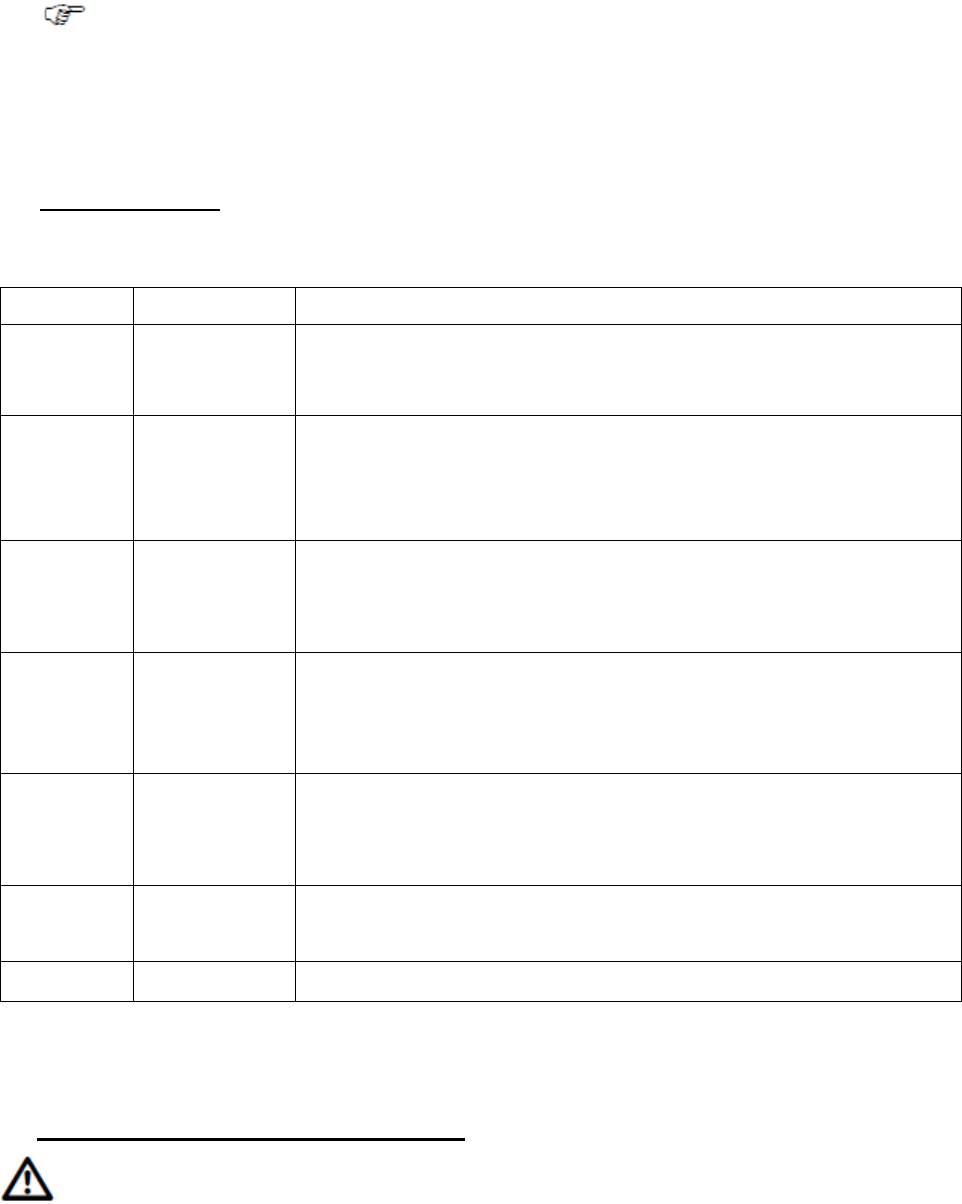
for your supply voltage.
Ensure that neither the mains adapter nor the cable are
damaged.
1.
Plug the adapter cable into the mains adapter socket (4)
in the
blood pressure monitor.
2. Plug the adapter plug into the wall socket.
When the mains adapter is connected, no battery current is
consumed.
12. Error Messages
If an error occurs during the measurement, the measurement is
interrupted and an error message,
e.g. «ERR 3», is displayed.
Error
Description
Potential cause and remedy
«ERR 1» Signal too
weak
The pulse signals on the cuff are too
weak. Re-position the cuff and
repeat the
measurement.*
«ERR 2»
(26)
Error signal During the measurement, error signals
were detected by the cuff,
caused for
instance by movement or muscle
tension. Repeat the
measurement,
keeping your arm still.
«ERR 3»
(23)
No pressure
in
the cuff
An adequate pressure cannot be generated in the cuff. A leak may
have
occurred. Check that the cuff is correctly
connected and is not
too loose. Replace
the batteries if necessary. Repeat the
«ERR 5»
Abnormal
result
The measuring signals are inaccurate
and no result can therefore be
displayed.
Read through the checklist for
performing reliable
measurements and
then repeat the measurement.*
«ERR 6»
AFIB/MAM
Mode
There were too many errors during the
measurement in AFIB/MAM
mode,
making it impossible to obtain a final
result. Read through the
checklist for
performing reliable measurements and
then repeat the
«HI» Pulse or cuff
pressure
too
The pressure in the cuff is too high (over
300 mmHg) OR the pulse
is too high
(over 200 beats per minute). Relax for 5
minutes and
«LO» Pulse too
low The pulse is too low (less than 40 beats
per minute). Repeat the
Please consult your doctor, if this or any other problem occurs
repeatedly.
If you think the results are unusual, please read through the
information in «Section 1.» carefully.
13. Safety, Care, Accuracy Test and Disposal
Safety and protection
This device may only be used for the purposes described in these instructions. The manufacturer
cannot be held liable for
damage caused by incorrect application.
•
This device comprises sensitive components and must be
treated with caution. Observe the
storage and operating conditions described in the «Technical Specifications» section.
•
Protect it from:

-
water and moisture
-
extreme temperatures
-
impact and dropping
-
contamination and dust
-
direct sunlight
-
heat and cold
•
The cuffs are sensitive and must be handled with care.
•
Do not exchange or use any other kind of cuff or cuff connector
for measuring with this device.
•
Only pump up the cuff once fitted.
•
Do not use this device close to strong electromagnetic fields
such as mobile telephones or
radio installations.
•
Do not use this device if you think it is damaged or notice
anything unusual.
•
Never open this device.
•
If the device is not going to be used for a prolonged period the
batteries should be removed.
•
Read the additional safety information in the individual sections
of this instructions.
Ensure that children do not use this device unsupervised;
some parts are small enough to be
swallowed.
Device care
Clean the device only with a soft, dry cloth.
Cleaning the cuff
Carefully remove spots on the cuff with a damp cloth and soapsuds.
WARNING: Do not wash the cuff in a washing machine or
dishwasher!
Accuracy test
We recommend this device is tested for accuracy every 2 years or
after mechanical impact (e.g.
being dropped). Please contact
Microlife-Service to arrange the test (see foreword).
Disposal
Batteries and electronic devices must be disposed of in
accordance with the locally
applicable regulations, not with
domestic waste.
14. Guarantee
This device is covered by a 5 year guarantee from the date of
purchase. The guarantee is valid
only on presentation of the guarantee card completed by the dealer (see back) confirming date of
purchase or the receipt.
•
Batteries and wearing parts are not included.
•
Opening or altering the device invalidates the guarantee.

•
The guarantee does not cover damage caused by improper
handling, discharged batteries,
accidents or non-compliance
with the operating instructions.
•
The cuff has a functional guarantee (bladder tightness) for 2 years.
Please contact Microlife-Service (see foreword).
14. Technical Specifications
Operating tempera- ture: 10 - 40 °C / 50 - 104 °F
15 - 95 % relative maximum humidity
Storage temperature: -20 - +55 °C / -4 - +131 °F
15 - 95 % relative maximum humidity
Weight: 320 g (including batteries)
Dimensions: 160 x 80 x 32 mm
Measuring procedure: oscillometric, corresponding to Korotkoff method: Phase I systolic,
Phase V diastolic
Measurement range: 20 - 280 mmHg – blood pressure
40 - 200 beats per minute – pulse
Cuff pressure display range: 0 - 299 mmHg
Resolution: 1 mmHg
Static accuracy: pressure within ± 3 mmHg
Pulse accuracy: ± 5 % of the readout value
Voltage source: 4 x 1.5 V Batteries; size AAA
Mains adapter DC 6V, 600 mA (optional)
Reference to standards: EN 1060-1 /-3 /-4; IEC 60601-1; IEC 60601-1-2 (EMC)
This device complies with the requirements of the Medical Device Directive 93/42/EEC.
Technical alterations reserved.
7KLVGHYLFHFRPSOLHVZLWK3DUWRIWKH)&&UXOHV2SHUDWLRQLVVXEMHFWWRWKHIROORZLQJWZRFRQGLWLRQV
WKLVGHYLFHPD\QRWFDXVHKDUPIXOLQWHUIHUHQFHDQG
WKLVGHYLFHPXVWDFFHSWDQ\LQWHUIHUHQFHUHFHLYHGLQFOXGLQJLQWHUIHUHQFHWKDWPD\FDXVHXQGHVLUHGRSHUDWLRQ
7KLVHTXLSPHQWKDVEHHQWHVWHGDQGIRXQGWRFRPSO\ZLWKWKHOLPLWVIRUD&ODVV%GLJLWDOGHYLFHSXUVXDQWWR
3DUWRIWKH)&&UXOHV7KHVHOLPLWVDUHGHVLJQHGWRSURYLGHUHDVRQDEOHSURWHFWLRQDJDLQVWKDUPIXO
LQWHUIHUHQFHLQDUHVLGHQWLDOLQVWDOODWLRQ7KLVHTXLSPHQWJHQHUDWHVXVHVDQGFDQUDGLDWHUDGLRIUHTXHQF\
HQHUJ\DQGLIQRWLQVWDOOHGDQGXVHGLQDFFRUGDQFHZLWKWKHLQVWUXFWLRQVPD\FDXVHKDUPIXOLQWHUIHUHQFHWR
UDGLRFRPPXQLFDWLRQV+RZHYHUWKHUHLVQRJXDUDQWHHWKDWLQWHUIHUHQFHZLOOQRWRFFXULQDSDUWLFXODULQVWDOODWLRQ
,IWKLVHTXLSPHQWGRHVFDXVHKDUPIXOLQWHUIHUHQFHWRUDGLRRUWHOHYLVLRQUHFHSWLRQZKLFKFDQEHGHWHUPLQHGE\
WXUQLQJWKHHTXLSPHQWRIIDQGRQWKHXVHULVHQFRXUDJHGWRWU\FRUUHFWWKHLQWHUIHUHQFHE\RQHRUPRUHRIWKH
IROORZLQJPHDVXUHV
5HRULHQWWKHUHFHLYLQJDQWHQQD
,QFUHDVHWKHVHSDUDWLRQEHWZHHQWKHHTXLSPHQWDQGUHFHLYHU
FRPSOLDQFHFRXOGYRLG\RXU
,
GLIIH
&KDQJHVRUPRGLILFDWLRQVQRWH[SUHVVO\DSSURYHGE\WKHSDUW\UHVSRQVLEOHIRUFRPSOLDQFHFRXOGYRLG\RXU
DXWKRULW\WRRSHUDWHWKHHTXLSPHQW
-.Connect the equipment into and outlet on a circuit different from that to which the receiver is connected.
-.Consult the dealer or an experienced radio/TV technician for help.
Changes or modifications not expressly approved by the party responsible for compliance could void your authority to
operate the equipment.